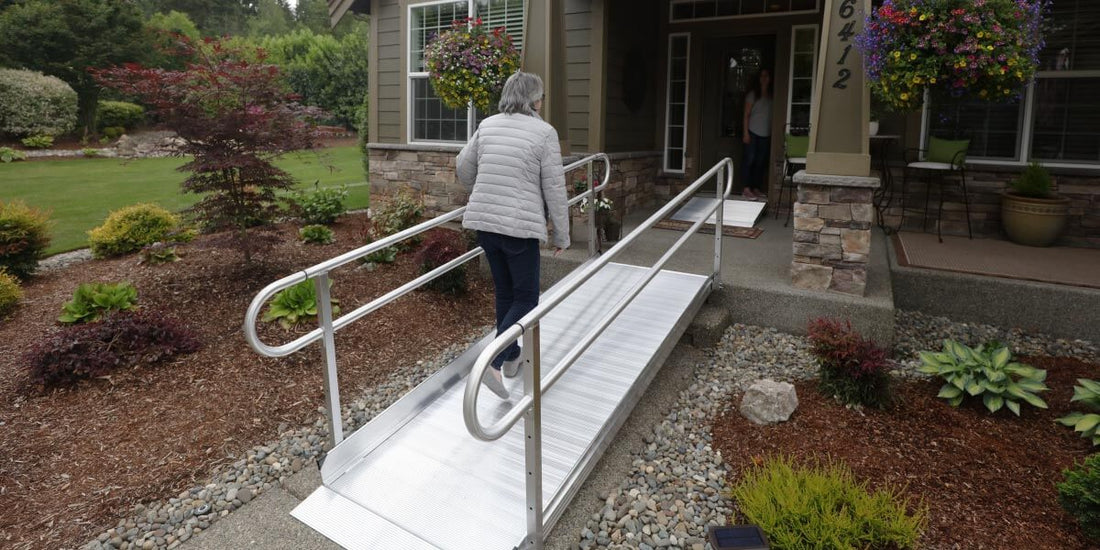Many families have made the decision to have their elderly loved ones age in place, rather than further risk their health by staying in a nursing home or other senior living facility. In this second of a two-part series blog, we’ll help you navigate the “noise” to better understand what may be required.
If you haven’t had a chance to read Part 1, head on over to learn more about how you can get prepared by implementing vital solutions to help eliminate trip hazards and make sure your loved ones can safely enter and move about their home.
Aids to daily living
Getting dressed, making the bed, and cooking are just a few daily activities that need to be done, and some of them cannot be accomplished without assistance. If this is true for your loved one, there are many solutions that can help.
Dressing aids:
Maintaining independence is all about completing daily tasks that allow the preservation of privacy and control. Oftentimes, even the simplest tasks, such as getting dressed, is no small feat. If your loved one has arthritis or general pain and/or stiffness, buttons, zippers, and shoelaces can be particularly troublesome. You can help ease their frustration and pain by adding products designed to assist with those tasks requiring fine motor skills. Examples of these products include:
- Buttonhook
- Foot funnel shoe assist
- Dressing stick
- Clothes with easy-grip zippers
- Lock laces for no-tie shoes
- WingsPants for wheelchair dressing
Reachers:
Reachers and grabbers can be extremely useful around the home. These tools can reach both high and low spaces, preventing bending, stretching, and the need for dangerous step stools. AgingInPlace has recently made a list of the best reachers and grabber tools, complete with a list of pros and cons for each style to help determine the best one for your loved one’s needs.
Mobility Accessories:
For individuals that use assistive mobility devices like wheelchairs, walkers, and scooters, mobility accessories are a great solution for keeping regularly used objects close by. Whether they need a water bottle on hand to stay hydrated, to keep their phone near them for emergencies, or don’t want to lose track of the book they’re reading, EZ-ACCESSORIES® can help with it all. Here is a list of just some of the accessories that can be added to their mobility equipment:
- Dual or single oxygen carrier
- Walker basket liner
- Scooter basket liner
- Wheelchair pack
- Scooter pack
- Wheelchair underneath carrier
COOKING:
Grocery or meal delivery services are especially helpful. Having fresh groceries delivered right to their doorstep is a convenience that allows your loved one to maintain their independence, while also freeing up family members to focus on other areas of care.
There are many different options, and due to the pandemic, many more companies are now offering this alternative service. Whether it's their local grocery store or a specialized service such as Instacart, this is a convenient option that's worth considering. There are also meal services such as HelloFresh, Home Chef, and many others that deliver full meal kits and easy instructions for preparation and cooking.
It's also a good idea to evaluate their kitchen and consider making adjustments for their safety if they will be cooking. Age oftentimes brings decreased reaction time, and the kitchen is one area where this can be particularly concerning.
- For quick access, move items from high shelves or cabinets to lower ones, or place things on the counter.
- Make sure there is a smoke alarm installed in the kitchen and a fire extinguisher is easily accessible.
- It is also a good idea to replace heavy and/or breakable cookware and bakeware with lighter weight materials.
Specialized Care
What level of care do they require? Do they need specialized personnel in order to administer care, or is it something that family members are qualified and available to handle? Care facilities have trained staff to handle all situations, so determining the level of care needed at home will need to be your top priority.
If qualified family members are not available or if they need a higher level of care, a visiting nurse or full-time caretaker may be the best solution. They can help with hygiene activities, administer daily medications, etc.
Socializing and Activities
Technology can be a great help with keeping family members connected. If they won’t be in a shared care facility with other individuals that they can socialize with and participate in activities led by the facility, you may want to think of some alternative ways that they can still maintain ample socialization. Think about getting your loved one a device capable of video chatting so they can not only talk to, but also see whoever they want to catch up with.
Cleaning, Maintenance, and Lawn Care
Think about hiring services to help with the upkeep of their home, both on the inside and the outside or consider creating a calendar with your family to appoint people certain tasks on certain days or weeks to help out. Washing windows, dusting, sweeping, vacuuming, and mowing the lawn are just a few of the reoccurring tasks that take a significant amount of effort.
We understand there is so much to think about when making a transition or decision like this sort. We are here to offer you and your loved ones support during this time and want to help ease this transition as much as possible. We hope this provided some ideas for how you can substitute the amenities and support that is freely offered to them in a care facility so they can still reap the benefits of those things in the comfort of their own home.

